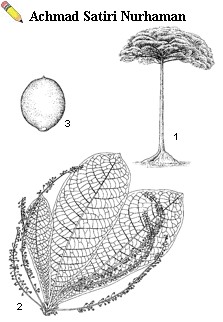Record Number
4708
PROSEA Handbook Number
5(2): Timber trees; Minor commercial timbers
Taxon
Terminalia copelandii Elmer
This article should be read together with the article on the genus: Terminalia in the Handbook volume indicated above in this database.
This article should be read together with the article on the genus: Terminalia in the Handbook volume indicated above in this database.
Protologue
Leafl. Philipp. Bot. 5: 1759 (1913).
Synonyms
Terminalia crassiramea Merr. (1917), Terminalia gigantea v. Slooten (1924), Terminalia catappoides C.T. White & Francis (1927).
Vernacular Names
Indonesia: ketapang darat, mertapang, lahajang pajo (Sumatra). Philippines: lanipau (general), yanipo (Mbo), dalipo (Palopo).
Distribution
Sumatra, Borneo, Flores, the Moluccas, the Philippines, New Guinea and the Solomon Islands.
Uses
The wood is used, e.g. for house construction, canoe making and veneer; the tree is also planted. The kernels of the fruits are edible. It has potential to stabilize river banks.
Observations
A fairly large tree up to 40 m tall, bole straight and cylindrical, usually short but sometimes up to 23 m long, up to 115 cm in diameter, with many large buttresses up to 2 m high, bark surface shallowly longitudinally cracking and flaking into small oblong pieces, grey or brown, inner bark pinkish; leaves obovate, 15—40 cm 4.5—18 cm, usually subcordate at base, sparsely pubescent and sometimes minutely verrucose below, with (20—)23—30 pairs of secondary veins, petiole very short, up to 10 mm long; flowers in an axillary spike 22—50 cm long, calyx tube fulvous-sericeous; fruit ovoid to ellipsoid, 3.5—6 cm 2.2—3 cm, nearly glabrous when mature, sometimes flattened or faintly 5-lobed. Terminalia copelandii is found in primary forest and swamp forest, both inland and in coastal regions, up to 500 m altitude. It has proven to grow well in monocultures. The density of the yellow-brown wood is 330—620 kg/m3 at 12% moisture content. See also the table on wood properties.
Image
 | Terminalia copelandii Elmer – 1, tree habit; 2, flowering twig; 3, fruit. |
Selected Sources
[26]Ashton, P.S., 1988. Manual of the non-dipterocarp trees of Sarawak. Vol. 2. Dewan Bahasa dan Pustaka, Kuala Lumpur. 490 pp.
[77]Burgess, P.F., 1966. Timbers of Sabah. Sabah Forest Records No 6. Forest Department, Sabah, Sandakan. xviii + 501 pp.
[99]Cockburn, P.F., 1976–1980. Trees of Sabah. 2 volumes. Sabah Forest Records No 10. Forest Department Sabah, Sandakan.
[162]Flora Malesiana (various editors), 1950–. Kluwer Academic Publishers, Dordrecht, Boston, London.
[234]Heyne, K., 1927. De nuttige planten van Nederlands-Indid [The useful plants of the Dutch East Indies]. 2nd edition, 3 volumes. Departement van Landbouw, Nijverheid en Handel in Nederlandsch-Indid, 's-Gravenhage. 1953 pp.
[289]Keating, W.G. & Bolza, 1982. Characteristics, properties and uses of timbers. Vol. 1. South-East Asia, northern Australia and the Pacific. Inkata Press Proprietary Ltd., Melbourne, Sydney & London. 362 pp.
[384]Lomibao, B.A., 1973. Wood anatomy of eight Terminalia species of the Philippine Combretaceae. Forpride Digest 11(3–4): 22–34.
[414]Meniado, J.A. et al., 1975–1981. Wood identification handbook for Philippine timbers. 2 volumes. Government Printing Office, Manila. 370 pp. & 186 pp.
[527]Reyes, L.J., 1938. Philippine woods. Technical Bulletin No 7. Commonwealth of the Philippines, Department of Agriculture and Commerce. Bureau of Printing, Manila. 536 pp. + 88 plates.
[666]van Vliet, G.J.C.M., 1979. Wood anatomy of the Combretaceae. Blumea 25: 141–223.
[715]Wisse, J.H., 1965. Volumegewichten van een aantal houtmonsters uit West Nieuw Guinea [Specific gravity of some wood samples from West New Guinea]. Afdeling Bosexploitatie en Boshuishoudkunde, Landbouwhogeschool Wageningen. 23 pp.
[718]Womersley, J.S. & Henty, E.E. (Editors), 1978–. Handbooks of the flora of Papua New Guinea. Melbourne University Press, Carlton.
[77]Burgess, P.F., 1966. Timbers of Sabah. Sabah Forest Records No 6. Forest Department, Sabah, Sandakan. xviii + 501 pp.
[99]Cockburn, P.F., 1976–1980. Trees of Sabah. 2 volumes. Sabah Forest Records No 10. Forest Department Sabah, Sandakan.
[162]Flora Malesiana (various editors), 1950–. Kluwer Academic Publishers, Dordrecht, Boston, London.
[234]Heyne, K., 1927. De nuttige planten van Nederlands-Indid [The useful plants of the Dutch East Indies]. 2nd edition, 3 volumes. Departement van Landbouw, Nijverheid en Handel in Nederlandsch-Indid, 's-Gravenhage. 1953 pp.
[289]Keating, W.G. & Bolza, 1982. Characteristics, properties and uses of timbers. Vol. 1. South-East Asia, northern Australia and the Pacific. Inkata Press Proprietary Ltd., Melbourne, Sydney & London. 362 pp.
[384]Lomibao, B.A., 1973. Wood anatomy of eight Terminalia species of the Philippine Combretaceae. Forpride Digest 11(3–4): 22–34.
[414]Meniado, J.A. et al., 1975–1981. Wood identification handbook for Philippine timbers. 2 volumes. Government Printing Office, Manila. 370 pp. & 186 pp.
[527]Reyes, L.J., 1938. Philippine woods. Technical Bulletin No 7. Commonwealth of the Philippines, Department of Agriculture and Commerce. Bureau of Printing, Manila. 536 pp. + 88 plates.
[666]van Vliet, G.J.C.M., 1979. Wood anatomy of the Combretaceae. Blumea 25: 141–223.
[715]Wisse, J.H., 1965. Volumegewichten van een aantal houtmonsters uit West Nieuw Guinea [Specific gravity of some wood samples from West New Guinea]. Afdeling Bosexploitatie en Boshuishoudkunde, Landbouwhogeschool Wageningen. 23 pp.
[718]Womersley, J.S. & Henty, E.E. (Editors), 1978–. Handbooks of the flora of Papua New Guinea. Melbourne University Press, Carlton.
Author(s)
M.S.M. Sosef
Correct Citation of this Article
Sosef, M.S.M., 1995. Terminalia copelandii Elmer. In: Lemmens, R.H.M.J., Soerianegara, I. and Wong, W.C. (Editors): Plant Resources of South-East Asia No 5(2): Timber trees; Minor commercial timbers. PROSEA Foundation, Bogor, Indonesia. Database record: prota4u.org/prosea

All texts are licensed under a Creative Commons Attribution-Noncommercial-Share Alike 3.0 Netherlands License
This license does not include the illustrations (Maps,drawings,pictures); these remain all under copyright.